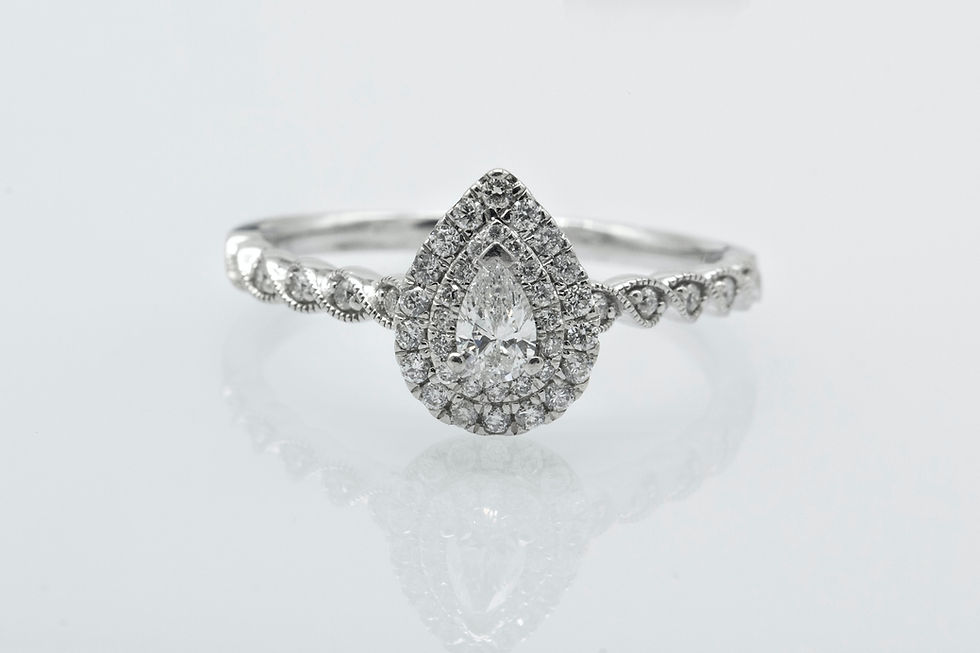Diamond Ring Buying Tips: What You Need to Know
- Steve Hoang Anh

- May 2
- 3 min read
Updated: Jun 21
When purchasing a diamond ring, one of the most crucial aspects to consider is the 4Cs: Cut, Clarity, Color, and Carat. These characteristics determine the quality, brilliance, and value of the diamond, ensuring buyers make an informed decision.

Cut refers to how well the diamond has been shaped to reflect light. A well-cut diamond maximizes brilliance, with precise proportions allowing light to enter and bounce back beautifully. Diamonds with excellent cut grades appear more radiant and visually stunning.
Clarity measures the presence of internal imperfections (inclusions) and external blemishes. The fewer these flaws, the higher the clarity grade. While flawless diamonds are rare and expensive, those with minor imperfections, often invisible to the naked eye, offer excellent value.
Color evaluates the diamond’s hue, ranging from D (colorless) to Z (light yellow or brown). The more colorless a diamond is, the higher its grade and value. While pure white diamonds are highly sought after, slightly tinted diamonds can also be beautiful when set in the right metal.
Carat represents the diamond’s weight. Larger diamonds are rarer and more valuable, but it’s essential to balance carat weight with cut quality to ensure maximum brilliance. A well-cut, smaller diamond may outshine a heavier one with a lower cut grade.

Selecting the Right Diamond Shape
Diamonds come in various shapes, each offering a distinct aesthetic and character. The round brilliant cut is the most popular, known for its superior sparkle and timeless appeal. Princess-cut diamonds, with their square shape, exude modern elegance, making them a favored choice for engagement rings. Emerald-cut diamonds have a rectangular shape with step-like facets, providing a sophisticated and vintage-inspired look.
Other options include oval, pear, marquise, and cushion-cut diamonds, each offering a unique style that suits different personalities. Choosing a diamond shape depends on personal preference and how well it complements the wearer’s hand and overall style.
Choosing the Best Setting for Your Diamond Ring
The setting plays a crucial role in showcasing the diamond’s beauty while ensuring durability. Prong settings, featuring small metal claws that hold the diamond, maximize light reflection, enhancing brilliance. Bezel settings, where a metal rim surrounds the diamond, provide extra protection and a sleek modern look.
For added sparkle, halo settings, which encircle the central diamond with smaller stones, create an illusion of a larger gem. Pavé settings, consisting of tiny diamonds along the band, add extra glamour to the ring. Selecting the right setting depends on lifestyle, design preference, and practicality for everyday wear.
Finding the Perfect Metal for Your Diamond Ring
The metal choice influences both the durability and aesthetic of the diamond ring. Yellow gold is a classic option, offering warmth and tradition, pairing beautifully with diamonds of slightly lower color grades. White gold provides a contemporary, sophisticated look, enhancing the brilliance of colorless diamonds. Rose gold, with its romantic pink hue, offers a unique and elegant vintage appeal. Platinum, known for its strength and hypoallergenic properties, is highly durable and ideal for securing diamonds.
Selecting the right metal depends on skin tone, style preference, and long-term durability considerations. Some metals require periodic maintenance, such as white gold, which may need occasional rhodium plating to retain its bright appearance.
Budget Considerations and Making a Smart Investment
Diamond rings range in price based on quality, size, and craftsmanship. Setting a clear budget ensures a practical yet valuable investment. Instead of prioritizing carat weight alone, focusing on cut quality maximizes brilliance even in smaller diamonds.
Buying from reputable jewelers guarantees authenticity and ethical sourcing, ensuring diamonds meet industry standards. Some jewelers offer certification, verifying the diamond’s quality based on the 4Cs, providing buyers with confidence in their purchase. Investing wisely in a well-crafted diamond ring ensures lasting beauty and value.
Final Thoughts
Choosing the perfect diamond ring involves careful consideration of the 4Cs, shape, setting, metal type, and budget. A well-selected diamond ring becomes more than an accessory—it symbolizes commitment, elegance, and timeless beauty. Whether opting for a classic solitaire or a dazzling halo design, a thoughtfully chosen diamond ring remains a cherished possession for generations.




Comments